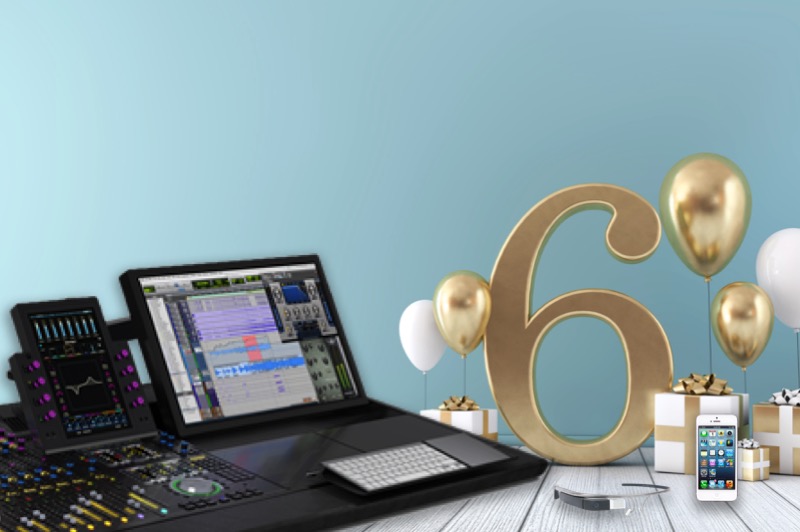Avid S6 has become the defacto standard in post-production rooms large and small in the nine years it’s been around.
Yep, nine years.
Still very much the latest technology, the current state-of-the-art, it’s somewhat surprising to consider that the launch of S6 was in September 2013, unveiled at the IBC Show in Amsterdam. Put in context, other technology to debut that year included the iPhone 5, PlayStation 4 and, for the lucky few on the prototype program with $1,500 to waste, Google Glass.
The Rise of the Used Avid S6
In fairness, drawing a comparison with the iPhone product lifecycle is not comparing apples with Apple. Drawing a comparison with Google Glass is downright rude. The technological tempo is very different and S6, along with the recently announced S4 is still very much at today’s leading edge.
It’s around this stage of any product’s lifecycle that the market spawns a secondary market and used examples begin to change hands.
Resurface has facilitated dozens of used Avid S6 sales; successfully connecting buyers and sellers from around the world. In order to understand the secondary S6 market, we can look at the factors driving supply and demand. This is probably best done in reverse order.
Demand
Having established itself as the standard, S6 is – by and large – the thing to have in audio post. There are many with a different preference of course, for DFC, Icon, System 5, Nuage… However the market tells us the most common scenario is that building or refurbing a room triggers the purchase of an S6. This, of course, is a substantial investment.
Historical price increases, and variable lead times, have prompted some buyers to ask the question of the secondary market. The most recent list price of a new 16 Fader M10 stood at $40k-ish, with S4 pricing looking similar when released. In some currencies, this will have crept up in increments by nearly 40-50% from launch pricing. At the top of the range, a 32 Fader M40 with 9 knobs and displays has followed the same trajectory, with today’s +/- $140k list pricing being nearly 50% higher than for the same spec desk in 2015 depending on where you are in the world.
Used Avid S6 console asking prices are typically 30-40% less. In a sector which is currently investing in Dolby Atmos to attract Netflix revenue, this cost saving is generally a similar figure, creating a kind of budgetary two-for-one.

Capital-intensive studio builds are generally not speculative; they’re necessitated by an imminent or existing increase in billable work. As such, they are rarely done with excessive time to spare. Here, demand in the used Avid S6 market has been created by fluctuating manufacturer lead times for new consoles. Customers with committed work and green-lit build projects have reported excessive or uncertain delivery schedules on their quoted S6, non-negotiable deadlines prompting them to look at what is available in time to deliver the job.
Demand (and supply) also comes from M10 users who are keen to embrace the additional functionality offered by M40, or to crossgrade to S4. Back in 2013, scrolling waveforms were a revelation (at least, to those who had never used an AMS Neve DFC), if perhaps a luxury. In the six years since, this functionality has proven itself, both as a time saver and a creative enhancement. For many it’s now a must-have. Driven also by the appeal of superior metering feedback offered previously only by the M40 or soon by S4 with display modules – the only way to level up from M10 to M40 or S4 is to sell used and re-buy, or double-down with the addition of the M10+ Option. This can either be done directly in the open market (used M10 to used M40) or with the help of a friendly S6-authorised reseller as the architect of a bespoke ‘used M10 to new M40 / S4 trade-up’.
Supply
Recently, S6 Consoles have begun to appear with regularity on the Resurface marketplace.
From our conversations with sellers, the reasons are many. Commonly the S6 seller is the end-user, upgrading or divesting an equipment asset. Resellers also find themselves with traded-in desks to sell on, having facilitated a swap-out for their customer and needing to balance out the deal after-the-fact.
Technology lifecycles also play a part. The age of S6 is significant here: Many businesses have a fixed 3 or 5-year technology investment cycle, even if that kit is being ‘refreshed’ like-for-like.
Recently, we helped a record producer S6 owner who had decided to retire, selling their studio gear in its entirety. Through Resurface, he was able to find a post house owner who was a) in need of an S6, b) ready to put work through it ASAP and c) happy to save around 20k on the cost of acquiring it. This combination of requirements from a buyer is not uncommon.
Para, Para, Paradox
Being very much a current product, S6 M40 seems in no apparent danger of going End of Sale, even if M10 has suffered that fate. It’s therefore possible, and highly advisable, for the used S6 buyer to contact their reseller and add Avid’s Expert Plus support contract to their purchase.
Having done so, their used console is covered with hardware warranty and 12 months of software updates. Feedback from customers is that individual S6 module faults are relatively common when compared with, say, Icon. Seemingly the remedy is most often a replacement module swap-out.
As a result, a strange thing happens: fanboys of Plutarch and other Ancient Greek historians will be familiar with the Ship of Thesus Paradox – better known to British sit-com enthusiasts as Trigger’s Broom.
Many used Avid S6 buyers with Expert Plus support contracts in place have found, bit by bit and over time, that their used console magically transforms into a new one.


